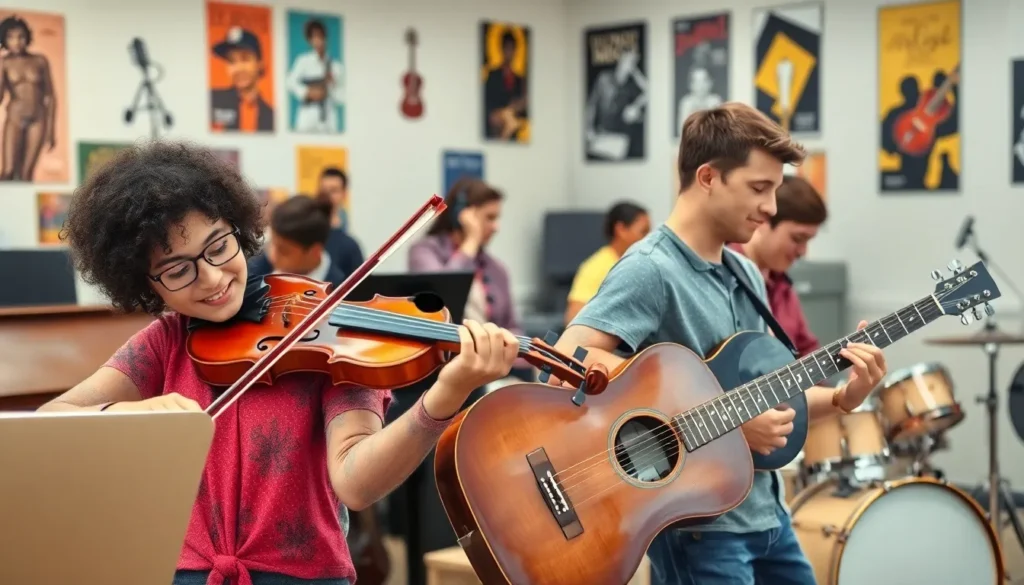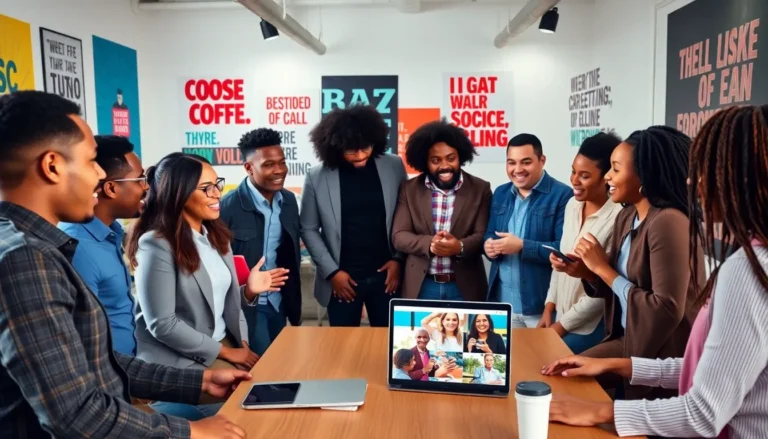Imagine strumming a guitar around a campfire or belting out a tune on the piano at a party. Learning an instrument isn’t just about hitting the right notes; it’s about unleashing creativity and discovering a world of rhythm. Whether it’s the soothing sound of a violin or the upbeat energy of a saxophone, every instrument offers a unique journey that can turn anyone into a musical maestro.
Table of Contents
ToggleOverview of Learning Instruments
Learning an instrument involves various factors that enhance musicality. Instruments come in different forms and styles, offering distinct paths for creativity. For example, a piano provides a versatile range of notes, while drums add rhythmic texture to music.
Fine motor skills develop with practice on instruments like the guitar and flute. Each instrument requires specific techniques, shaping the player’s overall ability. The violin, with its expressive capabilities, encourages emotional engagement through music.
Diverse genres suit different instruments, influencing the learning experience. Classical music often pairs with strings, and jazz frequently features brass instruments. Learners may choose to focus on one genre or explore multiple styles.
Technology aids in the learning process through apps and online tutorials. Many platforms offer structured lessons, fostering skill development at an individual pace. Utilizing these resources can accelerate progress and maintain motivation.
Regular practice is crucial for mastering any instrument. Setting aside time daily or weekly strengthens muscle memory and increases confidence. Short, focused sessions often yield better results than infrequent, longer practices.
Engagement with a musical community provides additional support. Joining groups, attending workshops, or taking part in performances connects learners with others. Such interactions encourage growth, inspiration, and collaboration.
Personal expression thrives through learning an instrument, allowing individuals to convey emotions. Each note played can reflect a unique story. Embracing the journey of learning instrument fosters a deeper appreciation for music and enhances overall well-being.
Types of Learning Instruments
Learning instruments typically fall into two broad categories: traditional and digital. Each type offers unique characteristics that enhance the musical journey.
Traditional Instruments
Traditional instruments encompass a wide range of options each with distinctive qualities. Instruments like guitars provide versatility suitable for various genres. The piano, revered for its wide range, combines melody and harmony effectively. Violins encourage emotional expression, often integral in classical music. Drums, known for their rhythmic foundation, help develop timing and coordination. Wind instruments, such as flutes and trumpets, demand breath control and precision. Learning these instruments fosters a sense of discipline and enriches one’s musicality through hands-on engagement.
Digital Instruments
Digital instruments represent a modern evolution in music creation. Electronic keyboards offer diverse sound options, allowing musicians to experiment with different styles. Software synthesizers enable sound manipulation, empowering creativity in unique ways. Music production apps on smartphones provide easy access to beginner-friendly features. MIDI controllers link performance and production, making composition more accessible. Learning digital instruments encourages exploration of technology’s role in music, cultivating innovative approaches to sound creation. Combining traditional techniques with digital tools enhances overall musical skill sets.
Benefits of Learning Instruments
Learning instruments provides numerous cognitive benefits, enhancing areas like memory and concentration. Studies indicate that musical training can significantly improve both verbal and spatial skills. Engagement in music strengthens neural connections in the brain, promoting better cognitive functions overall.
Developing discipline and patience occurs naturally while learning to play an instrument. Practicing regularly requires commitment, fostering a strong work ethic among learners. Gaining these traits can positively influence academic performance and life skills.
Building social connections emerges as another advantage. Playing in groups or participating in ensembles encourages teamwork and cooperation. Musical communities offer a support system that fosters collaboration and shared experiences.
Emotional expression plays a crucial role in mastering an instrument. Music serves as an outlet for feelings, allowing individuals to communicate what words can’t express. Many find that this creative expression contributes to improved mental health and well-being.
Enhancing fine motor skills is essential when learning an instrument. Instruments like the piano or violin require precise finger movements, which develop coordination and dexterity. Such skills translate into greater control over daily tasks.
Boosting self-esteem also follows improved musical skills. Achieving milestones, whether learning a new song or mastering a technique, cultivates a sense of accomplishment. This newfound confidence often extends beyond music, impacting various aspects of life.
Finally, developing a deeper appreciation for music enriches cultural understanding. Exposure to diverse genres broadens musical horizons, allowing individuals to connect with different traditions. Enjoyment of music becomes a shared experience, fostering unity and shared appreciation among diverse audiences.
Challenges in Learning Instruments
Learning an instrument presents unique challenges that can impact a learner’s journey. Understanding these obstacles is crucial to overcoming them effectively.
Accessibility Issues
Accessibility often poses significant barriers in learning instruments. Not all individuals have equal access to instruments, lessons, or suitable environments. Financial constraints limit options for many aspiring musicians, making quality instruments expensive. Geographic location also affects availability; rural areas might lack music schools or instructors. Furthermore, disabilities can create additional challenges that traditional instruments may not accommodate. Programs promoting instrument sharing and community resources aim to address these issues. Advocating for accessible music education helps build inclusive opportunities.
Motivation and Engagement
Maintaining motivation proves essential in the learning process. Initial excitement can diminish as challenges arise, leading to frustration. Setting realistic goals fosters a sense of achievement; students achieve milestones and feel encouraged. Engaging with a supportive community enhances motivation through shared experiences. Incorporating technology like apps or online tutorials creates interactive ways to learn. Exploring diverse musical genres keeps the experience fresh and inspiring. Consistent practice rooted in personal interest boosts commitment and enjoyment while navigating the complexities of learning instruments.
Conclusion
Learning to play an instrument opens doors to creativity and self-discovery. Each note played is not just a step toward mastery but a journey filled with emotional expression and personal growth. Whether one chooses a traditional or digital instrument, the experience enriches lives in countless ways.
The skills developed through musical training extend beyond the instrument itself, enhancing cognitive abilities and fostering social connections. Overcoming challenges along the way cultivates resilience and determination. Engaging with a supportive community and exploring diverse musical genres can make the learning process even more rewarding.
Ultimately, the adventure of learning an instrument is about more than just music; it’s a pathway to a deeper understanding of oneself and the world.











